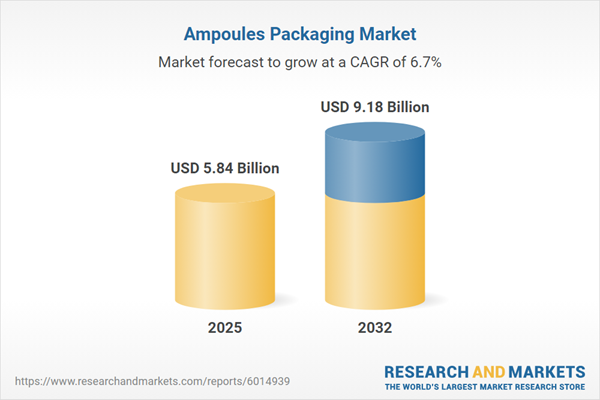Speak directly to the analyst to clarify any post sales queries you may have.
The ampoules packaging market is advancing rapidly, shaped by evolving regulations, innovative materials, and the integration of digital technologies. For senior decision-makers, this environment calls for proactive strategies to address compliance, resilience, and differentiation.
Ampoules Packaging Market Snapshot
The global ampoules packaging market is experiencing steady growth, with increasing demand rooted in expanded applications across biopharmaceuticals, diagnostics, and cosmetics. Higher industry standards regarding sterile packaging are influencing every aspect of supply chains, as scrutiny escalates throughout the sector. Both established manufacturers and new entrants are being driven to improve agility and responsiveness as regulations and customer requirements continue to diverge on a regional basis. The growing emphasis on healthcare and life sciences is setting new expectations for safety and quality, compelling stakeholders to prioritize operational flexibility and technological upgrades to stay competitive.
Ampoules Packaging Market Scope & Segmentation
This report delivers detailed segmentation, supporting strategic procurement and innovation planning for organizations aiming to strengthen their positioning in the ampoules packaging market.
- Applications: Biotechnology, pharmaceuticals, diagnostics, and cosmetics each introduce specific technical and regulatory demands that shape solution development and supplier partnerships.
- Materials: Glass (Types I, II, III) and plastics play vital roles in ensuring compatibility with chemical compounds, safeguarding product integrity, and providing robust lifecycle performance.
- Product Types: Single-dose and multi-dose ampoules affect dosing precision and influence warehousing, shipping, and supply logistics.
- End Users: Hospitals, clinics, laboratories, and research institutes each bring distinct packaging requirements, directly influencing procurement strategies and supplier focus.
- Packaging Technologies: Blow-Fill-Seal and conventional methods facilitate better automation, lower contamination risks, and more dependable processes in environments subject to regulatory oversight.
- Filling Volumes: Varying ampoule sizes meet specialized therapeutic needs and operational preferences, allowing supply strategies to remain targeted and adaptable.
- Sterility Options: Sterile and non-sterile packaging provide tailored options for risk control and meet cost considerations in different regulatory or market contexts.
- Geographical Coverage: Markets in the Americas, Europe, Middle East, Africa, and Asia-Pacific are influenced by distinct regulatory frameworks and logistics, driving regional variations in supplier strategies and growth priorities.
- Key Manufacturers: Leading companies including Schott AG, Gerresheimer AG, SGD Pharma, Stevanato Group, Corning Incorporated, Nipro Corporation, Bormioli Pharma, Şişecam Cam Ambalaj, Zignago Vetro, and Hi Tech Glass play key roles in technological advancement and industry direction.
Ampoules Packaging Market: Key Takeaways for Senior Decision-Makers
- Emerging advancements in glass and polymer coatings are improving compatibility and extending durability, enabling stronger supplier relationships while reducing performance risks.
- The increased deployment of digital monitoring and automated production is strengthening traceability and compliance, which is especially relevant for biopharmaceutical and pharmaceutical packaging solutions.
- Collaborating with life sciences partners is shortening product development timelines, empowering companies to respond to new therapeutic requirements and speed time-to-market for packaging innovations.
- Prioritizing modular and scalable manufacturing can improve agility, allowing organizations to align production capacity with shifting demand dynamics and resource optimization needs.
- Adoption of recyclable and lightweight materials not only fulfills regulatory and customer sustainability expectations but also supports environmentally conscious procurement.
- Regional strategies must reflect varying expectations: established markets focus on regulatory compliance and technical excellence, while Asia-Pacific and Middle Eastern regions emphasize reliability and cost control in their supplier arrangements.
Tariff Impact: Navigating Market Resilience
Recent tariff shifts in the United States have raised material costs within the ampoules packaging market. In response, organizations are reassessing sourcing, intensifying supplier vetting, and bolstering cross-border collaboration. Enhanced logistics planning and robust supplier networks are essential for maintaining continuity and managing the challenges of an unpredictable trade environment. Flexible manufacturing solutions and diversified sourcing are gaining importance as companies work to sustain performance under evolving tariff pressures.
Methodology & Data Sources
This analysis is built on direct interviews with executives, insights from subject matter experts, and careful examination of industry reports, regulatory updates, and patent data. The research blends qualitative and quantitative inputs to present actionable, balanced market intelligence.
Why This Report Matters
- Provides senior leadership with clarity on critical segments, enabling the optimization of procurement, automation, and supply chain strategies for enhanced operational results.
- Helps organizations manage regulatory and sustainability risks by guiding strategic planning as compliance obligations evolve worldwide.
- Delivers direction for developing adaptive, resilient go-to-market plans that account for shifting regional priorities and supply conditions.
Conclusion
This report equips decision-makers with strategic intelligence for navigating the ampoules packaging market. Leveraging these insights supports informed leadership and sustained compliance amid ongoing industry change.
Additional Product Information:
- Purchase of this report includes 1 year online access with quarterly updates.
- This report can be updated on request. Please contact our Customer Experience team using the Ask a Question widget on our website.
Table of Contents
3. Executive Summary
4. Market Overview
7. Cumulative Impact of Artificial Intelligence 2025
Companies Mentioned
The companies profiled in this Ampoules Packaging market report include:- Schott AG
- Gerresheimer AG
- SGD Pharma S.A.S.
- Stevanato Group S.p.A.
- Corning Incorporated
- Nipro Corporation
- Bormioli Pharma S.p.A.
- Şişecam Cam Ambalaj Sanayi ve Ticaret A.Ş.
- Zignago Vetro S.p.A.
- Hi Tech Glass Limited
Table Information
| Report Attribute | Details |
|---|---|
| No. of Pages | 194 |
| Published | October 2025 |
| Forecast Period | 2025 - 2032 |
| Estimated Market Value ( USD | $ 5.84 Billion |
| Forecasted Market Value ( USD | $ 9.18 Billion |
| Compound Annual Growth Rate | 6.6% |
| Regions Covered | Global |
| No. of Companies Mentioned | 11 |









